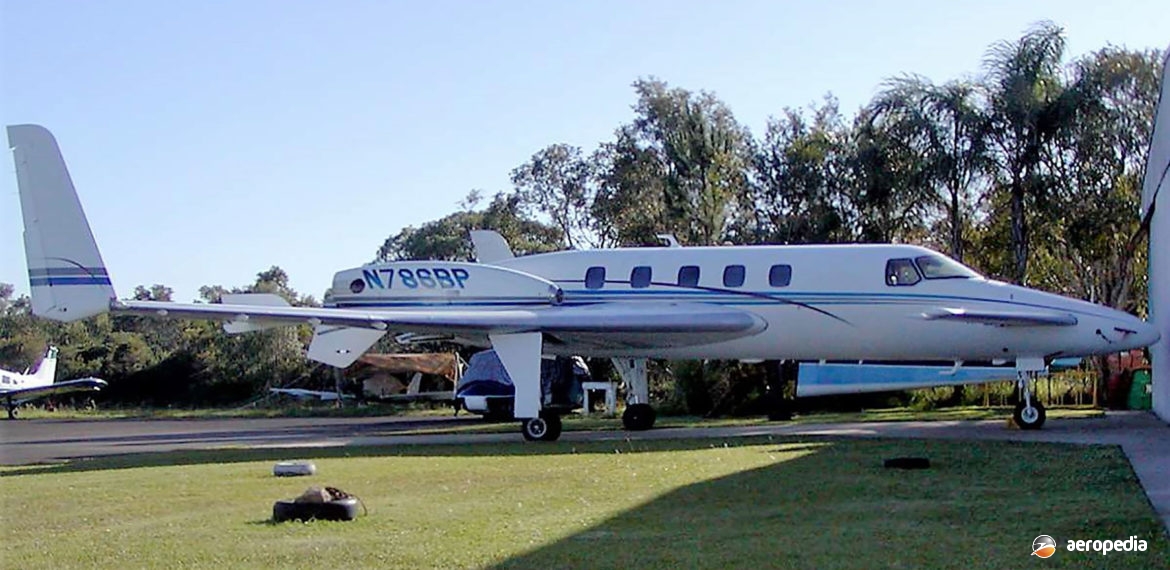Photograph:
Beech 2000 Starship N788BP at the Queensland Air Museum, Caloundra (Ron Cuskelly)
Country of origin:
United States of America
Description:
Business and executive transport
Power Plant:
Two 895 kw (1,200 shp) Pratt & Whitney Canada PT6A-67A turboprops
Specifications:
- Wingspan: 16.6 m (54 ft 5 in)
- Length: 14.05 m (46 ft 1 in)
- Height: 3.94 m (12 ft 11 in)
- Wing area: 16.1 m² (280.9 sq ft)
- Max cruising speed at 7,620 m (25,000 ft): 622 km/h (386 mph)
- Economical cruising speed at 11,280 m (37,000 ft): 496 km/h (308 mph)
- Initial rate of climb: 905 m/min (2,969 ft/min)
- Service ceiling: 10,610 m (34,800 ft)
- Single-engine ceiling: 5,580 m (18,300 ft)
- Cruising range at 7,620 m (25,000 ft): 1,990 km (1,237 miles)
- Fuel capacity: 1,120 litres (466 Imp gals)
- Max range: 2,630 km (1,634 miles)
- Empty weight: 4,575 kg (10,085 lb)
- Loaded weight: 6,577 kg (14,500 lb)
History:
The Beech Starship project was revealed to the aviation industry at the National Business Aviation Association (NBAA) Convention in 1983 shortly after an 85 per cent proof-of-concept aircraft was flown at Mojave in California, USA. The new radical design owed much to the influence of Bert Rutan but he was not the designer. Its genesis can be traced back to 1978 when Beech commenced development prior to Rutan’s company, Scaled Composites, becoming involved as a consultant.
The plan of Beech Aircraft Corporation was to design and build a larger, faster, turboprop corporate aircraft using composite construction, engines providing 746 kw (1,000 shp), which could lift a 5,670 kg (12,500 lb) aircraft to 12,497 m (41,000 ft), and reach 644 km/h (400 mph). Beech claimed the Starship would have a fuel efficiency at least 25 per cent better than a jet of comparable size, at a cost of a bit less speed, but which offered its passengers levels of comfort ahead of any other twin turboprop.
The configuration was finalised in October 1982 and the proof-of-concept aircraft flew ten months later on 29 August 1983. The decision to go into production was made in April 1985. The first full-scale aircraft made its maiden flight on 15 February 1986. The first Starship I N2000S (c/n NC-1) was first flown on 14 June 1986 and began flight testing; the second N3042S (c/n NC-2), like all production aircraft, being built at the Beech Aircraft Corporation’s Plant IV in Wichita, Kansas, USA.
After the first flight the manufacturer announced it intended to deliver 50 aircraft within two years of the first production Starship (c/n NC-5). The third full-scale pre-production prototype N3234S (c/n NC-3) left the test programme for a period for a US tour of committed customers, c/n NC-4 being the first production Starship I. In June 1986 N3234S (c/n NC-3) flew to Le Bourget to appear at the Paris Air Show. In 1989 N2000S (c/n NC-4 – the third time this registration had been used on a Starship) was also shown at the Paris Air Show.
The Starship was an eight to ten-seat business turboprop aimed at the lower end of the business market but with the ability to operate in and out of airfields too small for jets. The key to the performance was aerodynamic efficiency and a design that enabled an aircraft larger than the King Air 300 to be 74 km/h (46 mph) faster at any altitude on the same power.
The Starship was of canard configuration, the foreplane adding lift, and total lift was shared between the wing and the foreplane with a combined lift distribution which minimised drag. The smooth laminar flow was aided by pusher turboprop engines which cleared the wing from the propeller slipstream, making a significant contribution to reducing drag.
Six pre-production Model 2000 Starship Is were built, three each for flight and static testing. In June 1992 an improved Model 2000A was introduced, featuring a new six-seat interior, increased fuel capacity, increased payload and maximum take-off weight, enhanced field, stall speed and range performance. It was certificated in April 1992.
In 1995, after three prototypes, 18 Starship 2000s and 32 Starship 2000As had been built, Beech announced suspension of Starship production after the 53rd production airframe had been completed, citing lack of customer interest. Beech then purchased back many of the sold aircraft and broke them up, the Company stating it would not provide further service for the type. A couple is known to survive in the United States.
One example of the Starship registration N2000S spent some time in Australia based at Bankstown, NSW, being a demonstrator for the local Beech distributor, arriving in Sydney, NSW in December 1993. It was shown at a number of aviation events and was regularly seen giving demonstrations around the country. However, it was not sold here and eventually was exported overseas.
On 4 October 2004 another Starship N788BP (c/n NC-28) arrived at Scone, NSW from the United States, later being flown to Caloundra, QLD on 24 November. This aircraft was built in 1992 for 86 BP Inc and was based in Florida. Following the withdrawal of the type from service it was acquired for its engines and the flight to Caloundra was its last. The engines were removed and the airframe presented to the Caloundra Technical College for aviation engineer training. Later it was donated to the Queensland Air Museum at Caloundra where, minus engines, it has been placed on display.

